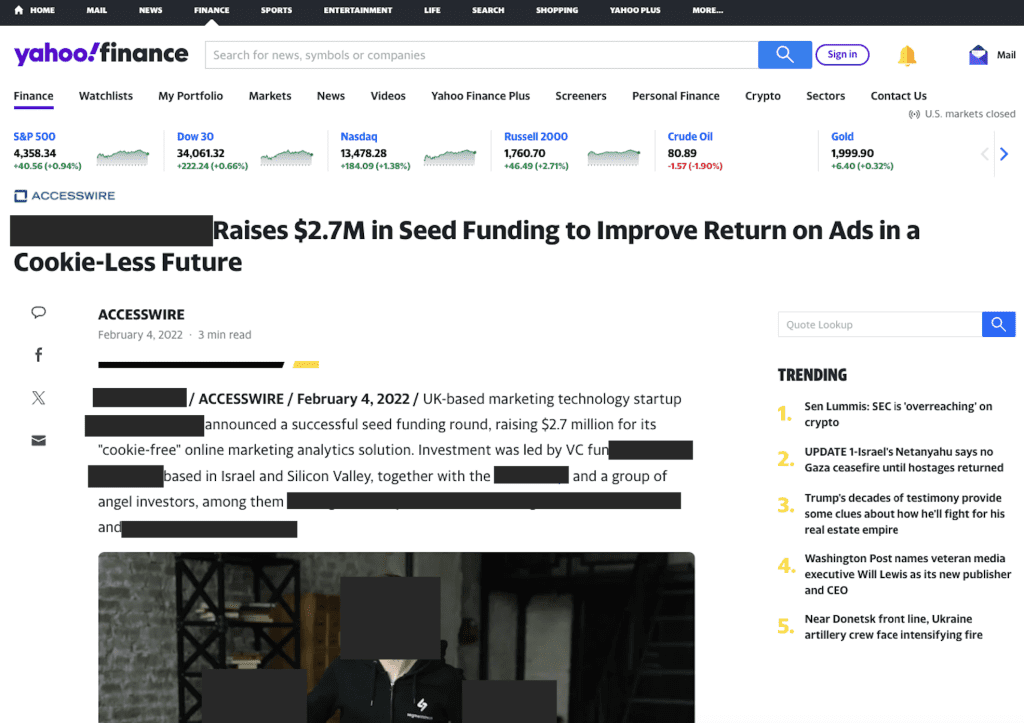Welcome to our first blog post with journalist insights that is not a “BUPR original”. We didn’t expect to write this, but the episode with Jason Feifer on Lenny’s Podcast was too packed with goodness to just let it pass. Big thanks and all / massive credit goes to Lenny.
Our idea here is to identify the bits that are most useful to our own community, that of European startups. All the things he said resonate with the material we are trying to share with the community, but, at the same time, there is nothing better than getting it straight from journalists! We’ve sliced and diced the material to bring you the best advice from Jason for you to pursue PR for your startup.
In case Jason Feifer needed any introduction, he is the Editor-in-Chief of Entrepreneur Magazine, a publication focusing on the journeys of overcoming challenges of startup and business entrepreneurs. Everyone in the US and beyond knows it and wants to be featured in it. Although it’s in most entrepreneurs’ target list, it shouldn’t, and Jason himself will tell us why.
So, with our three short paragraphs done, let’s cut to the chase:
You better not send a light-hearted pitch
According to Jason, “to reach out to someone in media is to be shouting over a lot of noise”. The last thing you want to do is fail to stand out. You don’t want to make your pitch seem like a template, and you don’t want it to be something unremarkable. What is an unremarkable pitch? Read on!
PR is not email marketing
Unfortunately, most PR pros simply blast press releases to a list or various lists. And they might not even know much about the people on the list. Jason highlights that, on the contrary, journalists want to see pitches that are targeted down to the individual. It’s not a numbers game in the way that email marketing is. So if your PR outreach looks like email marketing, stop right there and rethink!
In PR, results are unpredictable
Obtaining coverage is in itself unpredictable. Of course there are certainties when it comes to specific opportunities, but when you pitch internationally renowned outlets (such as Entrepreneur) for profile stories, then it’s a whole different world. There are a whole range of things that might prevent the piece from happening. Conversely, Jason also admits that you might get lucky with a low-effort attempt.
Jason also underlines that, even if you are successful in your pitch, the impact a piece of coverage will have in the short term is unpredictable. He has had people report to him about articles that brought real sales traction to their company, but also people who got absolutely nothing tangible from it.
Brand equity is often more important than reach
For Jason Feifer, brand equity and being able to say “I was in Entrepreneur”, for example, by adding an “As seen in” together with logos and links to the outlets in the company’s website, emails and other channels, can be more valuable than the article itself.
Jason himself does this on his personal website:

Readership numbers and UVM are not the North Star
Another thing Jason recommends to founders is not to let readership numbers guide their targeting. Not just because the immediate results of any piece are unpredictable, but also because it’s simply the wrong guiding principle. It prevents companies from focusing on the outlets that are truly relevant to their business.
There’s aiming high and then there’s aiming wrong – just don’t send out irrelevant pitches
You need a good reason to pitch journalists. And you want to make sure the pitch is relevant, so they will be receptive. Just because media brands like Entrepreneur, Inc or Fast Company are where most entrepreneurs feel they should be, it doesn’t mean that your story will be relevant to those outlets. If you pitch them aimlessly, chances are you are just going to annoy those journalists. And that means journalists may be less likely to open your emails in the future.
Plus, you are just wasting your time. Jason also highlights how PR is a ton of work, and if you only go for the unattainable, it will all be wasted energy and effort anyways. If you go for realistic targets with relevant pitches, that’s where you will find the goldilocks zone.
Think of pitching media as you would of pitching investors
Throughout the conversation, Jason Feifer highlights how entrepreneurs that are able to fundraise successfully often fail to understand the logics that govern the media and how journalists think. So he suggests thinking of pitching media in the same way as pitching investors. You wouldn’t raise money unless you knew exactly what it’s for, and you wouldn’t contact a VC firm without having done your homework. Would you?
Just as you would adapt to the investor with your pitch email, deck and so on, you should learn to adapt to the journalist and media outlet in question. You wouldn’t waste the time of an investor, why would you waste the time of a journalist then?
Don’t confuse journalists with service providers
A lot of entrepreneurs go in with a pitch based on their perception that they ‘deserve’ an article. They believe their success is enough to warrant a piece. But that’s not how it works, outlets are not ‘directories’ of entrepreneurs or businesses, no matter how successful. The way to actually look at it is: how can you help the journalist serve their audience? Do you have a story that fits what the journalist writes about? Different outlets, and even journalists, look for different stories. Perhaps, if anything, you should think of yourself as the service provider! Leave your ego behind and you’re far more likely to find success.
Advice for hiring PR agencies
PR “is a ton of work”, so it makes sense to hire PR professionals that can cut out that work. But they also have the experience and expertise to more effectively pitch the media. However, there are a lot of bad PR pros out there, especially the ones that focus on blasting press releases.
By the way, you can also check out our blog post on choosing the right fit PR agency for your startup.
Avoid agencies that suggest blasts and wires
For Jason Feifer, there are many indicators that can tell you whether it’s a good or bad agency. If an agency suggests to you, as a startup, to use wires, you should “run away”. He claims no journalists (or readers at all) read them. In a way, it’s a deceiving tactic. Outlets appearing on reports with their UVMs and DAs will reflect the wrong numbers. Press releases on those outlets go to ‘special’ sections that nobody cares about or reads. So they don’t really count as a win. This is what Jason is referring to:

By the way, we wrote a little something on how wires are sucky, here.
Avoid “yes men”
Another thing to look out for is “yes men or women”. A good PR professional can get in the shoes of a journalist. Meaning they will likely push back on a lot of ideas from the founders. This is good. Entrepreneurs should want PR pros that push back. Otherwise, it would likely lead to irrelevant pitches and annoyed journalists.
Look for relationships and sector expertise
For Jason, the most important thing to look out for in PR pros is relationships with journalists and sector expertise. Not because they can call in favours or get anything they want published – that doesn’t work! No, it’s because they are likely to understand what journalists are looking for. Knowing journalists is helpful because their messages and pitches are more likely to get seen, and perhaps looked at closely, but it obviously won’ guarantee coverage.
Tactical pitch tips
Do not call journalists! And don’t DM, to be on the safe side, although it’s a mix of preferences when it comes to direct messages. The email should have no more than 3 short paragraphs. Aim to explain the story in a way that the journalist could see him or herself telling it.
The subject line should have something that indicates relevance – journalists have full inboxes and their instinct is to quickly scan through them to delete what’s irrelevant as fast as possible. Journalists’ instincts is to track stories by themselves. Normally, journalists want to go directly to the sources that they believe are the best to pursue a story. So a PR pitch has to be good enough to stop that instinct of tracking stories themselves. And with good, we don’t mean click bait.
Pitching Entrepreneur
According to Jason, Entrepreneur doesn’t care about the company, or even the entrepreneur, or even the success. It might sound harsh, but that’s how all publications work. What they do care about is the audience, and delivering the stories the audience seeks. In the case of Entrepreneur, its audience looks for stories of entrepreneurs that overcome a challenge in a unique and enlightening way, one that will make for interesting insight for other entrepreneurs. Entrepreneur is a publication of mainly national and international reach, so it’s also less likely to be interested in hyper-local businesses.
Finally, don’t pitch Jason himself! As Editor in Chief, he’s not the best person to look at individual pitches or stories – your best bet is looking at writers who seem to write on relevant subjects. Oh, and Entrepreneur doesn’t really do ‘beats’.
You landed an interview? It’s not over yet!
In-depth stories need interviews. They are an important part of the article-creation process. Which means that entrepreneurs should be prepared for them. According to Jason, the best way to face them is by being open and vulnerable. Attempting to be controlling, cagey, could lead to the opportunity falling through. Depending on the outlet, it could lead the journalist to pursue a different approach and to a negative article.
What can you do if you are a ‘boring’ company?
Jason Feifer highlights that, for some companies, by nature it will be extremely difficult to pursue press in outlets like Entrepreneur or Fast Company. However, other approaches could work for them. For instance, a charismatic founder or CEO could develop PR on a personal level and, once they build their reputation, comment on trends and news. Another approach could be to pitch trend stories in which the company is not the central focus, but of which it is a part. Finally, data stories can be a powerful tool to create stories, either from a company’s own intelligence, or with stats commissioned by a research agency.
Jason Feifer’s biggest advice: Be human
Jason’s final and most important advice. Be human. The worlds of media and PR are interlinked by human relationships. Journalists don’t want to read jargon or hear a founder ‘selling’ on the interview. Blasting press releases is not human. If you are human with the reporter, it’s more likely for things to go your way.
Further links
All of Black Unicorn PR’s Journalist’s Insights series
Full show notes on Lenny’s Podcast
Episode with Jason Feifer on YouTube
Jason Feifer’s newsletter: One Thing Better



